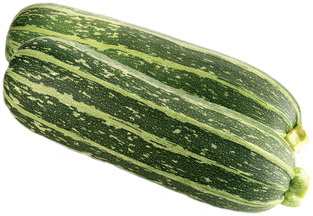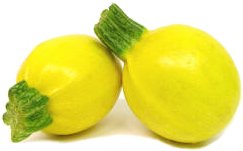

Marrow

(courgette, zucchini). Cucurbita pepo. Cucurbitaceae. The marrow (often known as vegetable marrow) is a bush or trailing annual producing large, cylindrical, edible fruits. Immature marrows of some cultivars are called courgettes or zucchini. The centre of origin is considered to be northern Mexico and the Southern United States. It is now widely distributed in many tropical and subtropical regions and can be cultivated outdoors in temperate regions during the summer period. It is primarily a summer vegetable but can be stored for use during the winter. Marrows require an open sunny site and a fertile, moisture-retentive but well-drained soil with a pH of 6.5-7.0. Well-rotted organic matter incorporated into the planting area will increase soil fertility and help retain sufficient moisture for growth. Excess manure, however, can lead to excessive leaf growth at the expense of fruit development. Marrows require a soil temperature or at last 13ºC for germination and are best sown in small pots under protection in the spring for planting out 4-5 weeks later when temperatures are higher. This should only be carried out after the risk of frost has passed and plants should be hardened off first. Later direct sowings can be made in the open or under cloches, placing two or three seeds per site at a depth of 2.5cm, thinning later to leave the strongest seedling. Spacing should be 90cm apart for the bush types and around 1.2m for the trailing types. Marrows must be kept very well watered at all stages but particularly during flowering. Mulching helps to reduce water loss from the soil surface. Marrows produce separate male and female flowers; these are insect-pollinated. Under cool conditions it is sometimes advantageous to assist the process by hand pollinating, carried out most easily by taking off male flowers and dabbing their pollen into the females, which can always be recognised by the immature ovary just below the perianth. Liquid feeding is beneficial, particularly during fruit swelling. Regular harvesting enables plants to continue producing over a longer period and increase total yield. Courgettes (young fruit) should be cut when about 10cm long, but where marrows are required, harvesting can start at between 15-20cm. Marrows to be stored should be allowed to develop to their full size. There are many vigorous high-yielding cultivars suitable for courgettes. These include ‘Early Gem’, with dark green fruits, which can also be grown on for marrows, and the yellow-fruited ‘Gold Rush’. ‘Long Green Trailing’ produces large marrows with pale and dark green stripes, and ‘Zebra Cross’ has white-striped fruits. Some recommended cultivars (green unless specified) are ‘Ambassador’, ‘Blondee’ (cream-white), ‘Brimmmer’, ‘Burpee Golden’, ‘Zucchini’ (yellow), ‘Onyx’ and ‘Rhondo de Nice’, with ball-shaped fruits. Relatively disease free when grown on a well-drained site. Seedlings should be protected from slug damage. Cucumber mosaic virus can present a problem in some seasons.
|
Home
Grow Nuts
Grow Herbs
Grow Fruit
Cyberian Index
If you like this website and want one of your own contact
Cyberian All information correct at
time of publication and open to updates as necessary. No part of this website,
or its vectors, may be produced in any shape or form, using any type or design
of medium, system, equipment or otherwise without the prior written consensual
notice of the Cyberian. Any breach of these requirements will result in the
appropriate action. If in doubt, e-mail contact is recommended.
Some components of this website were obtained as open-source software and are
used in the same non-profit manner on this website.